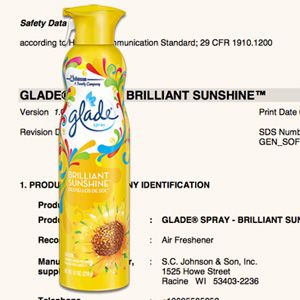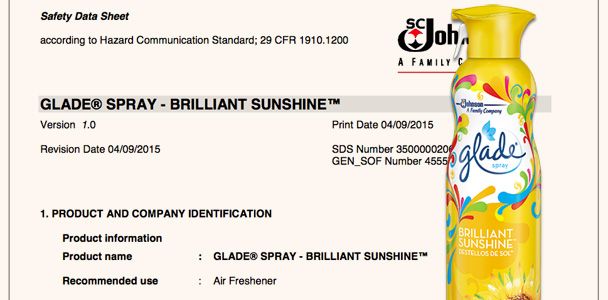We may be compensated if you purchase through links on our website. Our team is committed to delivering honest, objective, and independent reviews on home products and services.
Have you ever wondered about the contents of those Glade plug-ins that fill your home with pleasant scents? Many consumers are curious about the ingredients in these popular air fresheners. In this article, we’ll explore the components of Glade fragrance plug-ins, their safety considerations, and alternative options for those seeking natural air freshening methods.
Understanding Glade Plug-In Ingredients
Glade plug-ins contain a variety of chemicals that work together to create long-lasting fragrances. Let’s take a closer look at the common ingredients found in these air fresheners and the difference between natural and synthetic fragrances.
Common Chemicals Found in Plug-Ins
Glade plug-ins typically contain a mixture of synthetic and natural chemicals. Some common ingredients include:
- 2-phenoxyethyl isobutyrate
- Diproplyene glycol
- Benzyl acetate
- Limonene
- Linalool
These chemicals serve various purposes, from carrying the fragrance to enhancing its longevity. While some of these names may sound unfamiliar, many are commonly used in the fragrance industry.
Natural vs. Synthetic Fragrances
Air fresheners often use a combination of natural and synthetic fragrances. Natural fragrances are derived from plant-based sources, while synthetic fragrances are created in a laboratory. Both types can be found in Glade plug-ins, with synthetic fragrances often being more cost-effective and consistent in scent production.
The Science Behind Fragrance Plug-Ins
Fragrance plug-ins release scents into the air using a combination of heat and evaporation. Understanding how these devices work can help you make informed decisions about using them in your home.
How Plug-Ins Release Scent
Glade plug-ins use electricity to heat a small reservoir of scented liquid. As the liquid warms, it evaporates and releases fragrance molecules into the air. This process continues as long as the device is plugged in and contains fragrance liquid.
Duration and Intensity of Fragrances
The duration and intensity of a plug-in’s fragrance can vary depending on several factors:
- The size of the room
- Air circulation
- Temperature and humidity
- The specific fragrance formula
Most Glade plug-ins are designed to last several weeks and have adjustable settings to control the intensity of the scent release.
Health and Safety Considerations of Glade Plug-Ins
While air fresheners can make our homes smell pleasant, it’s important to consider potential health impacts. Let’s examine some of the safety considerations associated with fragrance plug-ins.
Potential Side Effects of Fragrance Plug-Ins
Some individuals may experience side effects from exposure to air fresheners, including:
- Headaches
- Nausea
- Respiratory irritation
- Skin irritation
These effects are more likely to occur in people with sensitivities or allergies to certain fragrances or chemicals.
Volatile Organic Compounds (VOCs) Explained
Volatile organic compounds (VOCs) are chemicals that easily evaporate at room temperature. Many air fresheners, including some Glade products, contain VOCs. While exposure to small amounts of VOCs is generally not harmful, prolonged exposure to high concentrations may pose health risks.

According to the Material Safety Data Sheet (MSDS) for Glade’s Brilliant Sunshine premium room spray, the product contains only 0.2% volatile organic compounds. The IAQ Index suggests that exposure to such a small amount is not harmful.
Environmental Impact of Fragrance Plug-Ins
The use of synthetic chemicals in air fresheners extends beyond health concerns to environmental impacts. The production, use, and disposal of these products contribute to pollution and waste. Synthetic fragrances and VOCs can enter the atmosphere, leading to air pollution. Proper disposal is also important to prevent chemicals from contaminating soil and water sources. Awareness of these impacts can guide consumers in making more eco-friendly choices.
SC Johnson’s Transparency Initiative
In response to growing consumer demand for product information, SC Johnson, the maker of Glade products, has taken steps to increase transparency about their ingredients.
SC Johnson Shares What’s Inside
SC Johnson launched a website to provide detailed information about the ingredients used in their products. This initiative allows consumers to access a comprehensive list of ingredients for each Glade fragrance product.
Consumer Demand for Ingredient Disclosure
A GlobalScan study commissioned by SC Johnson found that over half of consumers were more likely to purchase products from companies that provided detailed fragrance information. This consumer demand has led to increased transparency across the industry.
Industry-Wide Influence
SC Johnson’s transparency initiative has set a precedent for other companies in the air freshener industry. Competitors are increasingly following suit, recognizing the value of providing consumers with clear ingredient information. This shift towards greater transparency benefits consumers, enabling more informed purchase decisions and fostering trust in brands that prioritize openness.
Decoding Chemical Names
Many of the ingredients listed on air freshener labels can be confusing to the average consumer. Let’s break down some common chemical names and explore resources for understanding these compounds.
Benzyl Acetate and Other Common Ingredients
Benzyl acetate is a good example of a chemical that sounds complex but has a simple explanation. It’s an ester formed by the condensation of benzyl alcohol and acetic acid, and it’s found naturally in many flowers. This explains its frequent use in floral-scented products.
Other common ingredients you might encounter include:
- Limonene: A citrus-scented compound found in many fruits
- Linalool: A naturally occurring terpene alcohol found in many flowers and spice plants
- Geraniol: A monoterpenoid and alcohol that’s a primary component of rose oil
Resources for Understanding Chemical Compounds
If you’re interested in learning more about the chemicals in your household products, consider these resources:
- PubChem: A database of chemical compounds and their properties
- ChemSpider: A free chemical structure database
- The Environmental Working Group’s Skin Deep Database: A resource for understanding chemicals in personal care products
Chemical Labels and Certifications
Look for certifications and labels that indicate a product has been tested for safety and environmental impact. Certifications such as Green Seal and EcoLogo provide assurance that products meet specific health and sustainability criteria. These certifications can guide consumers towards safer, more environmentally friendly air freshener options.
Material Safety Data Sheets (MSDS)
Material Safety Data Sheets provide valuable information about the safety and handling of chemical products. Understanding how to read these documents can help you make informed decisions about the products you use in your home.
What MSDS Reveals About Products
MSDS documents contain detailed information about:
- Chemical identity and characteristics
- Fire and explosion hazard data
- Health hazard data
- Proper handling and storage procedures
- Emergency response procedures
This information is important for understanding potential risks associated with a product and how to use it safely.
How To Read and Interpret MSDS
When reading an MSDS, focus on these key sections:
- Hazards identification: Outlines potential health and physical hazards
- Composition/information on ingredients: Lists the chemical components of the product
- First aid measures: Provides instructions for handling exposure to the product
- Handling and storage: Offers guidance on safe use and storage
- Exposure controls/personal protection: Outlines necessary safety equipment and exposure limits
Remember, MSDS are designed for professional use, so some technical language may be present. If you’re unsure about any information, consult with a professional or contact the manufacturer for clarification.
Regulation and Standards for Fragrance Plug-Ins
Air fresheners, like many household products, are subject to various regulations and standards to ensure consumer safety. Awareness of these regulations can provide additional reassurance about the products you use.
Regulatory Bodies and Standards
Several agencies regulate the safety and labeling of air fresheners, including:
- The Environmental Protection Agency (EPA)
- The Food and Drug Administration (FDA)
- The International Fragrance Association (IFRA)
These agencies establish guidelines and standards for the safe use of chemical ingredients in consumer products. Compliance with these regulations ensures that products meet safety and quality standards.
Importance of Compliance
Adherence to regulatory standards not only ensures consumer safety but also promotes industry best practices. Companies that comply with these standards demonstrate a commitment to consumer health and environmental responsibility. Understanding these regulations can help consumers make informed choices about the products they bring into their homes.
Alternatives to Fragrance Plug-Ins
For those concerned about the chemicals in commercial air fresheners, there are many natural alternatives available. These options can provide pleasant scents without the use of synthetic fragrances.
Natural Air Freshening Methods
Consider these natural methods to keep your home smelling fresh:
- Open windows regularly to allow fresh air circulation
- Use houseplants known for air-purifying properties, such as spider plants or peace lilies
- Place bowls of baking soda around your home to absorb odors
- Use essential oil diffusers with natural, plant-based oils
- Simmer herbs and spices on the stove for a natural room scent
DIY Scent Solutions
Creating your own air fresheners can be a fun and eco-friendly alternative. Try these simple DIY recipes:
- Citrus and herb simmer pot: Combine sliced lemons, rosemary sprigs, and vanilla extract in a pot of simmering water
- Essential oil room spray: Mix water, witch hazel, and your favorite essential oils in a spray bottle
- Lavender sachets: Fill small fabric bags with dried lavender to place in drawers or hang in closets
Benefits of Natural Alternatives
Natural air fresheners offer several advantages over their synthetic counterparts. They often contain fewer harmful chemicals, reducing the risk of health issues. Additionally, natural alternatives are typically more environmentally friendly, contributing less to pollution and waste. Many natural air fresheners can also be customized with essential oils and herbs to create unique, personalized scents.
Our Conclusion
Understanding what’s inside your Glade fragrance plug-in can help you make informed decisions about the products you use in your home. While these air fresheners are generally safe when used as directed, some individuals may prefer natural alternatives due to sensitivities or environmental concerns. Whether you choose to continue using plug-in air fresheners or opt for natural alternatives, the key is to make choices that align with your personal health preferences and environmental values.

